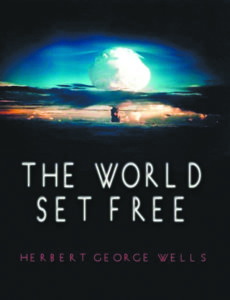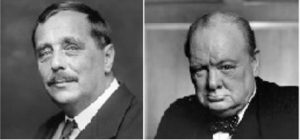

My children know that I love trivia, especially historical trivia. Not long ago, I received an e-mail from my eldest daughter asking “Did you know this, Mom?” Her e-mail read as follows:
“The atom bomb was one of the defining inventions of the 20th Century. So how did science fiction writer HG Wells predict its invention three decades before the first detonations? Written in 1913, nearly 30 years before the Manhattan Project started, Wells’ ‘The World Set Free’ describes cities around the world being devastated by what he called ‘atomic bombs.’”
After doing several internet searches, I was pleasantly surprised to learn that this was, indeed, true.
A futurist, Wells wrote a number of utopian works and foresaw the advent of airplanes, tanks, space travel, satellite television, nuclear weapons, and something resembling the World Wide Web.
According to James Gunn, founder of the Gunn Center for the Study of Science Fiction, one of Wells’ major contributions to the science fiction genre was his approach, which he referred to as his “new system of ideas.” In his opinion, the author should always strive to make the story as credible as possible, even if both the writer and the reader knew certain elements are impossible, allowing the reader to accept the ideas as something that could really happen, today referred to as “the plausible impossible” and “suspension of disbelief.” Wells said that a science fiction story should contain only a single extraordinary assumption. Being aware the notion of magic as something real had disappeared from society, he, therefore, used scientific ideas and theories as a substitute for magic to justify the impossible.

The story of the atom bomb starts in the Edwardian age, when scientists such as Nobel Prize winner Ernest Rutherford (30 August 1871 – 19 October 1937) were grappling with a new way of conceiving the physical world.
HG Wells first imagined a uranium-based hand grenade that “would continue to explode indefinitely” in his 1914 novel The World Set Free.
He even thought it would be dropped from planes. What he couldn’t predict was how a strange conjunction of his friends and acquaintances – notably Winston Churchill, who’d read all Wells’ novels twice, and the physicist Leo Szilard – would turn the idea from fantasy to reality, leaving them deeply tormented by the scale of destructive power that it unleashed.
Wells was fascinated with the new discoveries. He had a track record of predicting technological innovations. Winston Churchill credited Wells for coming up with the idea of using aeroplanes and tanks in combat ahead of World War One.

The two men met and discussed ideas over the decades, especially as Churchill, a highly popular writer himself, spent the interwar years out of political power, contemplating the rising instability of Europe.
Churchill grasped the danger of technology running ahead of human maturity, penning a 1924 article in the Pall Mall Gazette called “Shall we all commit suicide?” In the article, Churchill wrote: “Might a bomb no bigger than an orange be found to possess a secret power to destroy a whole block of buildings – nay to concentrate the force of a thousand tons of cordite and blast a township at a stroke?”
Early in 1939, the world’s scientific community discovered that German physicists had learned the secrets of splitting a uranium atom. Fears soon spread over the possibility of Nazi scientists utilizing that energy to produce a bomb capable of unspeakable destruction.
Einstein penned a letter to President Roosevelt urging the development of an atomic research program later that year. Roosevelt saw neither the necessity nor the utility for such a project, but agreed to proceed slowly. In late 1941, the American effort to design and build an atomic bomb received its code name — the Manhattan Project.
A breakthrough occurred in December 1942 when Enrico Fermi, a scientist who had fled to the United States from Fascist Italy, led a group of physicists to produce the first controlled nuclear chain reaction under the grandstands of Stagg Field at the University of Chicago.
The Manhattan Project was a research and development undertaking during World War II that produced the first nuclear weapons. It was led by the United States with the support of the United Kingdom and Canada. From 1942 to 1946, the project was under the direction of Major General Leslie Groves of the U.S. Army Corps of Engineers. Nuclear physicist Robert Oppenheimer was the director of the Los Alamos Laboratory that designed the actual bombs.
Two types of atomic bombs were developed concurrently during the war: a relatively simple gun-type fission weapon and a more complex implosion-type nuclear weapon. The Thin Man gun-type design proved impractical to use with plutonium, and therefore a simpler gun-type called Little Boy was developed that used uranium-235, an isotope that makes up only 0.7 percent of natural uranium. Chemically identical to the most common isotope, uranium-238, and with almost the same mass, it proved difficult to separate the two. Three methods were employed for uranium enrichment: electromagnetic, gaseous and thermal. Most of this work was performed at the Clinton Engineer Works at Oak Ridge, Tennessee.
In parallel with the work on uranium was an effort to produce plutonium. After the feasibility of the world’s first artificial nuclear reactor was demonstrated in Chicago at the Metallurgical Laboratory, it designed the X-10 Graphite Reactor at Oak Ridge and the production reactors in Hanford, Washington, in which uranium was irradiated and transmuted into plutonium. The plutonium was then chemically separated from the uranium, using the bismuth phosphate process. The Fat Man plutonium implosion-type weapon was developed in a concerted design and development effort by the Los Alamos Laboratory.
The first nuclear device ever detonated was an implosion-type bomb at the Trinity test, conducted at New Mexico’s Alamogordo Bombing and Gunnery Range on 16 July 1945. Little Boy and Fat Man bombs were used a month later in the atomic bombings of Hiroshima and Nagasaki, respectively. Those blasts hastened the end of the war and helped halt further war deaths in the Pacific Theater.
H.G. Wells had predicted not only the mushroom cloud we associate with atomic bombs, but their lasting radiation as well.
Wells died of unspecified causes on August 13 1946, aged 79, at his home in London. Wells had stated that his epitaph should be: “I told you so. You damned fools.”
Sources: www.technovelgy.com; Wikipedia.com; ushistory.org; bbb.com;
People reacted to this story.
Show comments Hide commentsGreat article!